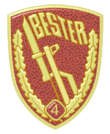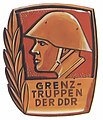Military best badge of the German Democratic Republic
The military best badges of the German Democratic Republic were the awards bestowed for special achievements since 1964. They were awarded to members of the National People's Army (NVA), the GDR border troops and civilians. In addition to badges of achievement , classification badges , rifle cords and military sports badges, the badge was one of the so-called “five soldier awards” of the NVA.
National People's Army Best Badge
In 1959, the Defense Minister of the GDR Willi Stoph formulated the goals and tasks of socialist competition and the best movement in the National People's Army. Various best titles should be awarded for exemplary collective performance . Starting in 1964, a special badge was created for the best titles, which could be awarded to soldiers, NCOs and officer students who showed at least "good" performance in all political, military and sporting activities. The best badge was 38 mm high, 31 mm wide and showed a soldier's head, a laurel symbol and the inscription “DDR NATIONALE PEOPLE ARMY” on a red painted background. The badge was worn on the right side of the uniform. The best badge could be awarded several times, but a maximum of three badges could be worn on the uniform at the same time. This regulation ceased to exist in 1969 with the introduction of special repeat trailers. The number of repetitions was entered on these 7 mm high and 17 mm wide tags. Up until 1982 it was possible to repeat the badge up to 25 times. This year the requirements for acquiring the mark have been increased significantly. After that, the best badge could only be awarded to those who were in possession of all other soldier awards possible for the respective service position. These included B. Sports badges, marksmen's cords and classification badges. The result was that from 1982 onwards, the repeat pendant was only awarded up to three times. Repetitions going beyond this were honored with additional badges or medals. For example, if they were repeated five times, there was also the NVA badge of achievement, if they were repeated seven times, there was also the NVA medal of merit in bronze, while nine or twelve times repetitions brought in the medals of merit in silver or gold.
The award of the title "Best" also included financial donations - graduated from 100 M to 500 M - as well as photos in front of the troop flag and entries in the troop unit's book of honor .
In 1984 the GDR planned a new badge, of which models were also made. This was 36 mm high, 28 mm wide and showed a portrait of a soldier surrounded by a laurel wreath on a red enamelled background. In the upper part was the word "BEST" and in the lower part was the state coat of arms of the GDR. A repeat tag was provided with up to three repetitions, with the number in black on a white background. This badge was never awarded.
From 1986 onwards, newly designed, shield-shaped badges were issued. This was 45 mm high, 34 mm wide and showed the barrel of a submachine gun with a mounted bayonet on a red painted background, with four oak leaves on the left and right of it. In the upper part there is the inscription "BEST". The repeat trailer used until then was no longer used and was replaced by a number that could be unscrewed, whereby the number "1" was screwed in when the title was first won. In this way, a maximum of the number “4” could be used for the third repetition.
Best badge of the border troops of the GDR
From 1981 a separate badge of the best was introduced for the border troops of the GDR. This was similar to the one awarded by the NVA, but bore the inscription "GRENZ-TROUPPEN DER DDR". In 1984 a newly developed badge was designed for the border troops, but it was never awarded. This was similar to the NVA model, but had a green painted background. Likewise, the final badge of the best, introduced in 1986, was similar to the NVA variant with the exception of the green background. The conditions for awarding the badge were in all respects the same as those required by the National People's Army.
literature
- Klaus Feder, Jürgen Wagner, Ralf Swoboda: Military badges of the German Democratic Republic. Military publishing house of the German Democratic Republic, Berlin 1988, ISBN 3-327-00523-0 .







